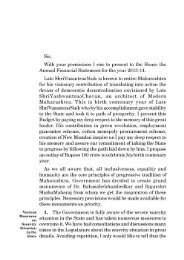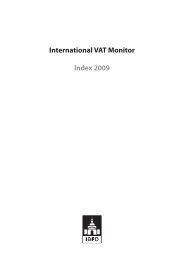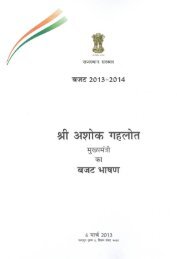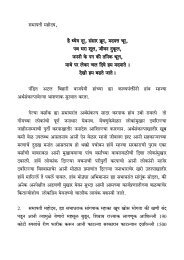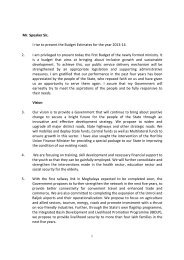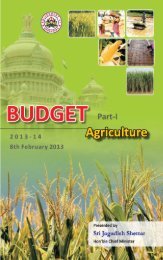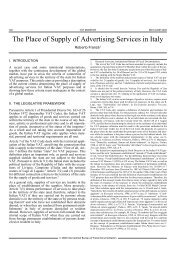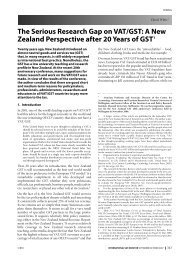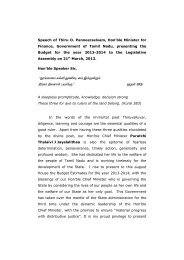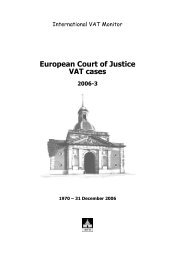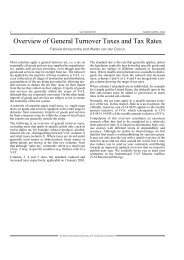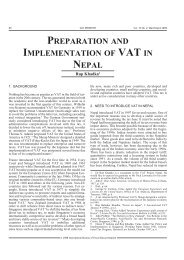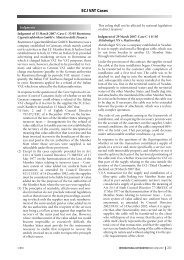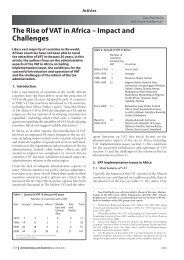The Miraculous Reduced Input Tax Credit for ... - empcom.gov.in
The Miraculous Reduced Input Tax Credit for ... - empcom.gov.in
The Miraculous Reduced Input Tax Credit for ... - empcom.gov.in
You also want an ePaper? Increase the reach of your titles
YUMPU automatically turns print PDFs into web optimized ePapers that Google loves.
<strong>The</strong> <strong>Miraculous</strong> <strong>Reduced</strong> <strong>Input</strong> <strong>Tax</strong> <strong>Credit</strong> <strong>for</strong><br />
F<strong>in</strong>ancial Supplies <strong>in</strong> Australia<br />
As <strong>in</strong> other jurisdictions, one of the key<br />
exemptions <strong>in</strong> Australia targets f<strong>in</strong>ancial<br />
supplies. In this article, the author expla<strong>in</strong>s<br />
how Australia has narrowed the scope of<br />
the exemption <strong>for</strong> f<strong>in</strong>ancial supplies and<br />
miraculously gives some bus<strong>in</strong>esses mak<strong>in</strong>g<br />
f<strong>in</strong>ancial supplies the right to deduct part of<br />
their <strong>in</strong>put tax. He expla<strong>in</strong>s the complexities of<br />
Australia’s f<strong>in</strong>ancial-supply rules, and discusses<br />
recent judicial decisions on this topic.<br />
1. Introduction<br />
Australia is a latecomer to value added tax (VAT) and<br />
its broad-based consumption tax is one of the so-called<br />
“New World VATs”. Not called VAT at all, the goods and<br />
services tax (GST) is an <strong>in</strong>voice-based type of VAT with<br />
relatively few exemptions. As <strong>in</strong> other jurisdictions, one<br />
of the key exemptions targets f<strong>in</strong>ancial supplies. In this<br />
notoriously vexed area of VAT, Australia has <strong>in</strong>troduced<br />
a system of narrow<strong>in</strong>g the scope of the exemption and of<br />
miraculously giv<strong>in</strong>g some suppliers the right to deduct<br />
7.5% 1 <strong>in</strong>put tax. Perversely, the Australian GST Law calls<br />
this entitlement to deduct a “reduced <strong>in</strong>put tax credit”<br />
and from this comes the title of this article because it has<br />
the effect of “reduc<strong>in</strong>g” the right to deduct <strong>in</strong>put tax from<br />
zero (which is normal <strong>in</strong> VAT systems <strong>for</strong> such supplies)<br />
to 7.5%.<br />
Although unusual and somewhat complex, the Australian<br />
approach has considerable merit, and it seems clear that<br />
its stated purpose of reliev<strong>in</strong>g the pressure <strong>in</strong> favour of<br />
self-supply has also had the effect of pacify<strong>in</strong>g the major<br />
f<strong>in</strong>ancial suppliers, which has removed the associated political<br />
pressure that might be expected from such a politically<br />
and economically powerful group.<br />
2. Background to the Australian Exemptions<br />
It is <strong>in</strong>terest<strong>in</strong>g to note that the exemptions established<br />
under the Australian GST were named <strong>in</strong> an unconventional<br />
manner which is possibly more reveal<strong>in</strong>g of their<br />
economic effect than the conventional VAT labels. Transactions<br />
that are called “zero rated” <strong>in</strong> other jurisdictions<br />
are labelled “GST-free” supplies <strong>in</strong> Australia to better reflect<br />
that, to the extent possible, f<strong>in</strong>al consumption bears<br />
no GST. 2 Supplies that are neither taxable nor GST free,<br />
i.e. are “exempt” <strong>in</strong> other jurisdictions, are called “<strong>in</strong>put<br />
taxed” under the Australian GST system to <strong>in</strong>dicate that<br />
f<strong>in</strong>al consumption bears the GST that was non-deductible<br />
<strong>in</strong> the process of production and distribution of the goods<br />
or services.<br />
316<br />
Australia<br />
Michael Walpole*<br />
GST-free supplies are relieved from taxation on the<br />
grounds that they concern merit goods and services, such<br />
as medical supplies and food <strong>for</strong> human consumption.<br />
<strong>Input</strong>-taxed supplies are dom<strong>in</strong>ated by immovable property<br />
and f<strong>in</strong>ancial and <strong>in</strong>surance services. <strong>The</strong> focus of this<br />
article will be on f<strong>in</strong>ancial supplies.<br />
3. F<strong>in</strong>ancial Supplies: <strong>The</strong> Problem<br />
<strong>The</strong> problem with f<strong>in</strong>ancial supplies is well known. It<br />
is difficult to identify the value that has been added by<br />
f<strong>in</strong>ancial <strong>in</strong>stitutions <strong>for</strong> the purposes of levy<strong>in</strong>g VAT<br />
(GST) on the difference between the cost of the supply<br />
to the supplier and the price the supplier charges to its<br />
customers. 3 Disentangl<strong>in</strong>g the components of the <strong>in</strong>puts<br />
and the supply is complex adm<strong>in</strong>istratively, and likely to<br />
be costly <strong>in</strong> compliance and adm<strong>in</strong>istration. Most jurisdictions<br />
us<strong>in</strong>g a traditional VAT model simply do not<br />
try, and they there<strong>for</strong>e exempt f<strong>in</strong>ancial supplies. 4 This<br />
approach avoids complexity, but it <strong>in</strong>troduces a distortion<br />
<strong>in</strong> that it makes “self-supplies” economically advantageous<br />
<strong>for</strong> a f<strong>in</strong>ancial supplier. S<strong>in</strong>ce f<strong>in</strong>ancial suppliers<br />
cannot claim <strong>in</strong>put tax <strong>in</strong> respect of <strong>in</strong>puts used <strong>for</strong> the<br />
purposes of mak<strong>in</strong>g their exempt f<strong>in</strong>ancial supplies, it<br />
makes sense <strong>for</strong> them to carry out activities “<strong>in</strong> house”.<br />
Aside from the so-called self-supply bias, there are other<br />
distortions and problems that have been identified as<br />
associated with “<strong>in</strong>put tax<strong>in</strong>g” f<strong>in</strong>ancial supplies, such<br />
as cascad<strong>in</strong>g of tax, bias to non-resident suppliers, and<br />
simple revenue loss. 5<br />
4. <strong>The</strong> Australian Solution<br />
When it designed the GST system, the Australian Federal<br />
Treasury was well aware of the experience of other<br />
countries <strong>in</strong> relation to these aspects of tax<strong>in</strong>g f<strong>in</strong>ancial<br />
services. In particular, the problem of the self-supply bias<br />
seems to have been high <strong>in</strong> the th<strong>in</strong>k<strong>in</strong>g of the designers of<br />
the Australian GST. It is very evident that the <strong>gov</strong>ernment<br />
was sensitive to risks and criticisms associated with the<br />
new tax when it was be<strong>in</strong>g planned <strong>in</strong> 1999: the legislation<br />
* Professor, Australian School of <strong>Tax</strong>ation and Bus<strong>in</strong>ess Law (Atax),<br />
Australian School of Bus<strong>in</strong>ess, University of New South Wales.<br />
1. 75% of Australia’s GST rate of 10%. See 4.3.<br />
2. See Secs. 9-30 and 38-1 of A New <strong>Tax</strong> System (Goods and Services <strong>Tax</strong>)<br />
Act1999 (Cth) (“GST Act”).<br />
3. See D. Williams, “Value Added <strong>Tax</strong>” <strong>in</strong> V. Thuronyi, ed., <strong>Tax</strong> Law Design<br />
and Draft<strong>in</strong>g,International Monetary Fund, 1996, Vol. 1, 1, p. 41.<br />
4. <strong>The</strong> problem of f<strong>in</strong>ancial services and the traditional approach are expla<strong>in</strong>ed<br />
by R. de la Feria and M. Walpole <strong>in</strong> “Options <strong>for</strong> <strong>Tax</strong><strong>in</strong>g F<strong>in</strong>ancial<br />
Supplies <strong>in</strong> Value Added <strong>Tax</strong>: EU VAT and Australian GST Models Compared”,<br />
(2009) 58 International and Comparative Law Quarterly, 1.<br />
5. Id, p. 11.<br />
INTERNATIONAL VAT MONITOR SEPTEMBER/OCTOBER 2011 © IBFD
was extensively changed prior to be<strong>in</strong>g passed by Parliament<br />
and it was subsequently further amended. 6 In fact,<br />
the legal rules relat<strong>in</strong>g to f<strong>in</strong>ancial supplies were repealed<br />
<strong>in</strong> their entirety shortly after enactment7 and replaced by<br />
a more flexible set of Regulations. 8<br />
<strong>The</strong>re are two essential elements <strong>in</strong> the Australian approach.<br />
9 <strong>The</strong> first element is that, under the regime <strong>for</strong><br />
“reduced <strong>in</strong>put tax credits” (RITC), f<strong>in</strong>ancial supplies are<br />
not wholly <strong>in</strong>put taxed, and the other is that the RITC<br />
regime is conf<strong>in</strong>ed to major suppliers of f<strong>in</strong>ancial services.<br />
By means of a de m<strong>in</strong>imis threshold, m<strong>in</strong>or f<strong>in</strong>ancial suppliers<br />
are removed from <strong>in</strong>put tax<strong>in</strong>g entirely and small<br />
players <strong>in</strong> the GST system can claim full deduction of<br />
<strong>in</strong>put tax <strong>for</strong> the GST they have <strong>in</strong>curred on <strong>in</strong>puts associated<br />
with mak<strong>in</strong>g m<strong>in</strong>or f<strong>in</strong>ancial supplies. Those features<br />
have the effect that, strictly speak<strong>in</strong>g, f<strong>in</strong>ancial supplies<br />
are not exempt from GST.<br />
4.1. F<strong>in</strong>ancial supplies<br />
<strong>The</strong> def<strong>in</strong>ition of “f<strong>in</strong>ancial supply” <strong>in</strong> Australia takes<br />
<strong>in</strong>to account “... both the nature of the service constitut<strong>in</strong>g<br />
a f<strong>in</strong>ancial supply, and the fact that the supplier of the<br />
service is, immediately be<strong>for</strong>e mak<strong>in</strong>g the supply, either<br />
the owner of the f<strong>in</strong>ancial supply or the creator of the f<strong>in</strong>ancial<br />
supply.” 10 Consequently, the mean<strong>in</strong>g of f<strong>in</strong>ancial<br />
supply is restricted to “<strong>in</strong>terests <strong>in</strong>” supplies of f<strong>in</strong>ancial<br />
services that are owned by the supplier or that the supplier<br />
has created. Such supplies are described by means of copious<br />
examples <strong>in</strong> the Regulations. 11 Examples of an <strong>in</strong>terest<br />
<strong>in</strong> a f<strong>in</strong>ancial supply owned by an entity immediately<br />
be<strong>for</strong>e its supply <strong>in</strong>clude “a share that is sold” and “rights<br />
assigned under a derivative”. Examples of an <strong>in</strong>terest created<br />
<strong>in</strong> a f<strong>in</strong>ancial supply <strong>in</strong>clude “a share or a bond that<br />
is issued” and “a derivative that is entered <strong>in</strong>to”. 12 <strong>The</strong>se<br />
examples illustrate the difference quite effectively.<br />
However, as with other complex laws, the problem faced<br />
by GST law (and the <strong>in</strong>tellectual attraction of it) is the<br />
penumbra – the supplies and actors <strong>in</strong> the mak<strong>in</strong>g of supplies<br />
that fall with<strong>in</strong> the grey area between these simple<br />
examples. <strong>The</strong> Regulations also cater <strong>for</strong> many of these <strong>in</strong>stances,<br />
however, and there is a regulatory determ<strong>in</strong>ation<br />
of “... supplies of a f<strong>in</strong>ancial character made by entities on<br />
the periphery to transactions.” 13 This categorization of peripheral<br />
types of supply is where the Australian rules are<br />
superior to those <strong>in</strong> other jurisdictions, where the courts<br />
are faced with the difficult task of f<strong>in</strong>d<strong>in</strong>g a path through<br />
the penumbra and have to determ<strong>in</strong>e at what po<strong>in</strong>t the<br />
exempt character of a f<strong>in</strong>ancial supply should start and<br />
end, especially end. As a result of the prescriptive nature<br />
of the Australian rules, issues such as that <strong>in</strong> the case of<br />
Volker Ludwig14 <strong>in</strong> the European Union and the str<strong>in</strong>g<br />
of cases be<strong>for</strong>e and (probably) after it could not readily<br />
arise <strong>in</strong> Australia. However, Australia has not completely<br />
elim<strong>in</strong>ated the risk of litigation <strong>in</strong> such matters.<br />
Suppliers and supplies made on the periphery of the narrow<br />
def<strong>in</strong>ition of f<strong>in</strong>ancial supply are treated differently.<br />
Accord<strong>in</strong>g to the Regulations, there is a further type of<br />
supplier which is not a f<strong>in</strong>ancial supplier but is a “f<strong>in</strong>ancial-supply<br />
facilitator”. <strong>The</strong> description of such a supplier<br />
<strong>The</strong> <strong>Miraculous</strong> <strong>Reduced</strong> <strong>Input</strong> <strong>Tax</strong> <strong>Credit</strong> <strong>for</strong> F<strong>in</strong>ancial Supplies <strong>in</strong> Australia<br />
is far from poetic, but it is clear: “a f<strong>in</strong>ancial-supply facilitator,<br />
<strong>in</strong> relation to a supply of an <strong>in</strong>terest, [<strong>in</strong> a f<strong>in</strong>ancial<br />
supply] is an entity facilitat<strong>in</strong>g the supply of the <strong>in</strong>terest<br />
<strong>for</strong> a f<strong>in</strong>ancial-supply provider”. 15<br />
For clarity’s sake, the Regulations go on to build on the<br />
fundamental categorization based on whether the supply<br />
is owned or created by the supplier. A further three types<br />
of supply are identified as follows:<br />
Reg. 40-5.09 sets out what supplies are f<strong>in</strong>ancial supplies (subject<br />
to the usual provisos concern<strong>in</strong>g consideration, supply <strong>in</strong> the<br />
course of an enterprise, etc.) <strong>in</strong> a table. Its 11 items <strong>in</strong>clude:<br />
– accounts made available <strong>in</strong> the course of an authorized bank<strong>in</strong>g<br />
bus<strong>in</strong>ess;<br />
– debts, credits, and letters of credit;<br />
– charges or mortgages over property;<br />
– annuities and allocated pensions; and<br />
– currency or an agreement to buy or sell currency. 16<br />
<strong>The</strong> Regulations then identify what is termed an “<strong>in</strong>cidental<br />
f<strong>in</strong>ancial supply”, which is def<strong>in</strong>ed <strong>in</strong> Regulation<br />
40-5.10. This is another attempt to provide clarity at the<br />
periphery and accepts that, although, strictly speak<strong>in</strong>g,<br />
some supplies might not be f<strong>in</strong>ancial supplies <strong>in</strong> their<br />
own right, they may nevertheless be <strong>in</strong>cidental. A supply:<br />
6. Id, p. 21.<br />
7. By A New <strong>Tax</strong> System (Indirect and Consequential Amendments) Act<br />
(No. 2) 1999 No. 177, 1999.<br />
8. In Australia, the advantage of Regulations is that they are approved by<br />
Parliament by means of a process requir<strong>in</strong>g scrut<strong>in</strong>y by the Senate Stand<strong>in</strong>g<br />
Committee on Regulations and Ord<strong>in</strong>ances, which means that they<br />
do not have to go through a series of <strong>for</strong>mal read<strong>in</strong>gs, as is required <strong>for</strong><br />
Bills. See Australia, House of Representatives, Mak<strong>in</strong>g Laws, September<br />
2008, at http://www.aph.<strong>gov</strong>.au/house/<strong>in</strong>fo/<strong>in</strong>fosheets/is07.pdf (accessed<br />
14 March 2010).<br />
9. R. de la Feria and M. Walpole, see note 4, pp. 21-22.<br />
10. Sec. 40-5.06 of aNew <strong>Tax</strong> System (Goods and Services <strong>Tax</strong>) Regulations1999<br />
(Cth) (“GST Regulations”). See R. de la Feria and M. Walpole,<br />
see note 4, pp. 21-22. What follows is based on, although not identical to,<br />
that description.<br />
11. GST Regulation 40-5.06.<br />
12. See “Examples of <strong>in</strong>terests” <strong>in</strong> GST Regulation 40-5.06.<br />
13. R. de la Feria and M. Walpole, see note 4, p. 22.<br />
14. Judgment of the Court of Justice of the European Union (ECJ) of 21 June<br />
2007 <strong>in</strong> Volker Ludwig v. F<strong>in</strong>anzamt Luckenwalde, Case C-453/05, [2007]<br />
ECR I-5083. Accord<strong>in</strong>g to the ECJ, the fact that a f<strong>in</strong>ancial adviser analyses<br />
the f<strong>in</strong>ancial situation of clients canvassed by him with a view to obta<strong>in</strong><strong>in</strong>g<br />
credit <strong>for</strong> them does not preclude recognition of the service supplied as<br />
be<strong>in</strong>g exempt negotiation of credit, if, <strong>in</strong> the light of the <strong>for</strong>ego<strong>in</strong>g <strong>in</strong>terpretative<br />
criteria, the negotiation of credit offered by that f<strong>in</strong>ancial adviser is<br />
considered the pr<strong>in</strong>cipal service to which the provision of f<strong>in</strong>ancial advice<br />
is ancillary, <strong>in</strong> such a way that the latter shares the same tax treatment as<br />
the <strong>for</strong>mer. <strong>The</strong> fact that the f<strong>in</strong>ancial adviser has no contractual l<strong>in</strong>k with<br />
any of the parties to a credit agreement to the conclusion of which he has<br />
contributed and that he does not establish direct contact with one of those<br />
parties does not preclude that adviser from provid<strong>in</strong>g a service of negotiation<br />
of credit which is exempt from VAT.<br />
<strong>The</strong> <strong>in</strong>terpretative criteria were the fact, first, that the services rendered<br />
by the agent and the f<strong>in</strong>ancial adviser (its subagent) were remunerated by<br />
the lenders only on the condition that the clients approached and advised<br />
by the f<strong>in</strong>ancial adviser entered <strong>in</strong>to a credit agreement, which suggests<br />
that the negotiation should be regarded as the pr<strong>in</strong>cipal service and the<br />
giv<strong>in</strong>g of advice as merely ancillary and second, that the negotiation of<br />
credit appeared to be the decisive service both <strong>for</strong> the borrowers and <strong>for</strong><br />
the lenders, <strong>in</strong> so far as the activity of giv<strong>in</strong>g f<strong>in</strong>ancial advice occurred<br />
only <strong>in</strong> a prelim<strong>in</strong>ary phase and was limited to help<strong>in</strong>g the client choose,<br />
from among the various f<strong>in</strong>ancial products, which were best adapted to his<br />
situation and to his needs.<br />
15. GST Regulation 40-5.07.<br />
16. R. de la Feria and M. Walpole, see note 4, p. 22.<br />
© IBFD INTERNATIONAL VAT MONITOR SEPTEMBER/OCTOBER 2011<br />
317
Michael Walpole<br />
318<br />
... is an <strong>in</strong>cidental f<strong>in</strong>ancial supply if:<br />
– it is <strong>in</strong>cidental to the f<strong>in</strong>ancial supply; and<br />
– it and the f<strong>in</strong>ancial supply are supplied at or about the same<br />
time, but not <strong>for</strong> separate consideration; and<br />
– it is the usual practice of the entity to supply the th<strong>in</strong>g, or<br />
similar th<strong>in</strong>gs, and the f<strong>in</strong>ancial supply together <strong>in</strong> the ord<strong>in</strong>ary<br />
course of the entity’s enterprise.<br />
F<strong>in</strong>ally, the Regulations close off the potential spread of<br />
the def<strong>in</strong>ition of “f<strong>in</strong>ancial supply” by mak<strong>in</strong>g it clear that<br />
certa<strong>in</strong> supplies, whatever ambiguity there may be <strong>in</strong> a<br />
normal read<strong>in</strong>g, are not f<strong>in</strong>ancial supplies. Regulation 40-<br />
5.12 identifies as “non-f<strong>in</strong>ancial supplies” items such as:<br />
– cheque and deposit <strong>for</strong>ms and books supplied to an<br />
Australian [authorized deposit-tak<strong>in</strong>g <strong>in</strong>stitution] <strong>in</strong><br />
connection with an account mentioned <strong>in</strong> item 1 <strong>in</strong><br />
the table <strong>in</strong> Regulation 40-5.09;<br />
– professional services, <strong>in</strong>clud<strong>in</strong>g <strong>in</strong><strong>for</strong>mation and advice,<br />
<strong>in</strong> relation to a f<strong>in</strong>ancial supply;<br />
– debt collection services;<br />
– trustee services;<br />
– custodian services <strong>in</strong> relation to money, documents<br />
and other th<strong>in</strong>gs;<br />
– Australian currency, or the currency of another country,<br />
the market value of which exceeds its stated value<br />
as legal tender ....<br />
It is clear that the Regulator has made every ef<strong>for</strong>t to<br />
elim<strong>in</strong>ate opportunities <strong>for</strong> argument. Indeed, the Regulations<br />
go a step further and, out of an abundance of caution,<br />
provide a generous “tiebreaker” rule <strong>for</strong> the situation<br />
where a supply might, on the def<strong>in</strong>itions, be both a f<strong>in</strong>ancial<br />
supply17 and a non-f<strong>in</strong>ancial supply. 18 In such cases, it<br />
is regarded as not be<strong>in</strong>g a f<strong>in</strong>ancial supply. 19 It seems that<br />
little has been left to chance.<br />
It will be apparent that the Australian approach, although<br />
bewilder<strong>in</strong>gly detailed to someone com<strong>in</strong>g to it afresh,<br />
is very clear <strong>in</strong> its restriction of categories of supplies<br />
regarded as f<strong>in</strong>ancial supplies <strong>for</strong> GST purposes and is<br />
similarly restrictive of the category of providers who<br />
make them. In any rema<strong>in</strong><strong>in</strong>g cases of doubt, it sets out a<br />
somewhat generous treatment as the default position. It<br />
is with<strong>in</strong> this tight legislative context, designed to reduce<br />
arguments and to limit the spread<strong>in</strong>g sta<strong>in</strong> of a f<strong>in</strong>ancial<br />
supply categorization, that the next two generous rules<br />
operate. <strong>The</strong> first of these rules is the de m<strong>in</strong>imis threshold<br />
applicable to f<strong>in</strong>ancial supplies.<br />
4.2. F<strong>in</strong>ancial acquisitions threshold<br />
As a result of the “f<strong>in</strong>ancial acquisitions threshold” 20 (or<br />
“FAT” <strong>in</strong> f<strong>in</strong>ance <strong>in</strong>dustry jargon), bus<strong>in</strong>esses that do not<br />
have the mak<strong>in</strong>g of f<strong>in</strong>ancial supplies as their ma<strong>in</strong> bus<strong>in</strong>ess<br />
or as a significantly large subsidiary part of it, do not<br />
need to identify their f<strong>in</strong>ancial supplies so as to strip out<br />
the <strong>in</strong>put tax associated with that part of their bus<strong>in</strong>ess.<br />
<strong>The</strong> FAT operates so that “... an acquisition is not treated<br />
as related to an <strong>in</strong>put-taxed supply if the only reason <strong>for</strong><br />
do<strong>in</strong>g so is that it relates to mak<strong>in</strong>g a f<strong>in</strong>ancial supply<br />
and the entity does not exceed the f<strong>in</strong>ancial acquisitions<br />
threshold.” 21 S<strong>in</strong>ce, perversely, the Australian rules contemplate<br />
that a borrow<strong>in</strong>g might be a f<strong>in</strong>ancial supply, 22<br />
the threshold has been made more generous and, there<strong>for</strong>e,<br />
more effective, by exclud<strong>in</strong>g from the threshold<br />
borrow<strong>in</strong>gs that are not entered <strong>in</strong>to <strong>for</strong> the purposes<br />
of mak<strong>in</strong>g f<strong>in</strong>ancial supplies. 23 Without that exclusion,<br />
bus<strong>in</strong>esses with a lot of borrow<strong>in</strong>gs might be subject to<br />
the GST regime <strong>for</strong> f<strong>in</strong>ancial supplies.<br />
<strong>The</strong> threshold applies to <strong>in</strong>put tax relat<strong>in</strong>g to acquisitions<br />
made <strong>in</strong> the course of mak<strong>in</strong>g f<strong>in</strong>ancial supplies<br />
and has the effect that an entity (mean<strong>in</strong>g a legal entity or<br />
<strong>in</strong>dividual) is entitled to full deduction of GST on <strong>in</strong>puts<br />
relat<strong>in</strong>g to f<strong>in</strong>ancial supplies, if the total <strong>in</strong>put tax (<strong>in</strong> that<br />
month and the preced<strong>in</strong>g 11) that relates to the supplies<br />
is less than AUD 50,00024 and less than 10% of the total<br />
amount of <strong>in</strong>put tax. 25 Thus, the threshold has two parts,<br />
both of which must be satisfied <strong>for</strong> the entitlement to full<br />
deduction of GST: both <strong>in</strong> absolute and relative terms,<br />
the <strong>in</strong>put tax relat<strong>in</strong>g to the mak<strong>in</strong>g of the f<strong>in</strong>ancial supplies<br />
must have been of m<strong>in</strong>or significance <strong>for</strong> 12 months<br />
(<strong>in</strong>clud<strong>in</strong>g the month <strong>in</strong> question).<br />
<strong>The</strong> special regime <strong>for</strong> f<strong>in</strong>ancial supplies applies if either<br />
or both thresholds are exceeded, i.e. the <strong>in</strong>put tax relat<strong>in</strong>g<br />
to the mak<strong>in</strong>g of the f<strong>in</strong>ancial supplies is more than<br />
AUD 50,000 or the <strong>in</strong>put tax is a significant component<br />
– namely more than 10% – of the total <strong>in</strong>put tax of the<br />
entity’s bus<strong>in</strong>ess <strong>for</strong> 12 months.<br />
<strong>The</strong> result of this threshold is that the special regime <strong>for</strong><br />
f<strong>in</strong>ancial supplies made by bus<strong>in</strong>esses applies only to<br />
those entities that have a high amount of <strong>in</strong>put tax associated<br />
with f<strong>in</strong>ancial acquisitions or that have a significant<br />
proportion of their <strong>in</strong>put tax attributable to their bus<strong>in</strong>ess<br />
of mak<strong>in</strong>g f<strong>in</strong>ancial supplies. For example, a plumber<br />
who grants loans to his customers <strong>in</strong> the <strong>for</strong>m of grant<strong>in</strong>g<br />
credit on bills <strong>for</strong> repairs will not be drawn <strong>in</strong>to the<br />
f<strong>in</strong>ancial-supply regime merely by reason of giv<strong>in</strong>g credit.<br />
One significant disadvantage of the FAT is the compliance<br />
cost associated with monitor<strong>in</strong>g the entity’s f<strong>in</strong>ancial<br />
affairs <strong>in</strong> relation to the threshold.<br />
<strong>The</strong> practical difficulty of this process is exacerbated by the fact<br />
that the threshold must be monitored not only currently and<br />
hav<strong>in</strong>g regard to the previous 11 months 26 but consideration<br />
must also be given to future acquisitions and an assumption made<br />
about the recovery of <strong>in</strong>put tax on f<strong>in</strong>ancial acquisitions made<br />
dur<strong>in</strong>g the month and the next 11 months. 27<br />
17. GST Regulation 40-5.09.<br />
18. GST Regulation 40-5.12.<br />
19. GST Regulation 40-5.08(2).<br />
20. Sec. 11-15(4) of the GST Act.<br />
21. R. de la Feria and M. Walpole, see note 4, p. 29.<br />
22. See GST Rul<strong>in</strong>g GSTR 2002/2, Para. 22, and GST Regulation 40-5.06.<br />
23. Sec. 189-15 of the GST Act.<br />
24. In order to adapt it to <strong>in</strong>flation and to reduce compliance cost, the FAT is<br />
to be <strong>in</strong>creased to AUD 150,000, with effect from 1 July 2012; see Australian<br />
Government, Implementation of the recommendations of Treasury’s<br />
review of the GST f<strong>in</strong>ancial supply provisions, Discussion paper June 2010:<br />
http://www.treasury.<strong>gov</strong>.au/documents/1840/PDF/Discussion_paper_<br />
GST_f<strong>in</strong>ancial_supplies.pdf, Para. 2.11 (accessed 30 Sept 2010).<br />
25. Sec. 189-5 of the GST Act.<br />
26. Sec. 189-5 of the GST Act.<br />
27. Sec. 189-10 of the GST Act. See R. de la Feria and M. Walpole, see note 4,<br />
p. 24.<br />
INTERNATIONAL VAT MONITOR SEPTEMBER/OCTOBER 2011 © IBFD
<strong>The</strong>se concerns partly expla<strong>in</strong> the recent decision to <strong>in</strong>crease<br />
the threshold. <strong>The</strong> comment has also been made<br />
that “... there are practical challenges associated with allocation<br />
and apportionment of <strong>in</strong>put tax to the mak<strong>in</strong>g of<br />
f<strong>in</strong>ancial supplies.” 28 <strong>The</strong> issue of apportionment associated<br />
with this aspect of the Australian f<strong>in</strong>ancial-supply<br />
rules is one that is shared <strong>in</strong> a significant way by the rest<br />
of the bus<strong>in</strong>esses.<br />
For bus<strong>in</strong>esses that pass the FAT, the prize <strong>in</strong> the Australian<br />
GST system is that they have access to the RITC rules<br />
and thus, although they make f<strong>in</strong>ancial supplies that are<br />
ostensibly <strong>in</strong>put taxed, they are entitled to claim a portion<br />
of the GST <strong>in</strong>curred <strong>in</strong> acquir<strong>in</strong>g <strong>in</strong>puts that are subsequently<br />
used <strong>in</strong> order to make f<strong>in</strong>ancial supplies.<br />
4.3. <strong>Reduced</strong> <strong>in</strong>put tax credits regime<br />
F<strong>in</strong>ancial suppliers of sufficient scale, measured by reference<br />
to the FAT, are able to participate <strong>in</strong> the RITC system.<br />
<strong>The</strong> GST Act29 conta<strong>in</strong>s a ref<strong>in</strong>ement under which<br />
“... acquisitions of a specified k<strong>in</strong>d that relate to mak<strong>in</strong>g f<strong>in</strong>ancial<br />
supplies can give rise to an entitlement to a RITC.<br />
<strong>The</strong>se are reduced credit acquisitions [“RCAs”].” 30 <strong>The</strong><br />
RITC granted under this rule is 75% of the full amount of<br />
the <strong>in</strong>put GST <strong>in</strong> question. 31 <strong>The</strong> bulk of the relevant rules<br />
are to be found <strong>in</strong> the GST Regulations.<br />
<strong>The</strong> Regulations list, <strong>in</strong> characteristically detailed tables,<br />
the items that are regarded as RCAs and have the effect<br />
that 75% of the GST charged by the f<strong>in</strong>ancial-supply facilitators<br />
is deductible. <strong>The</strong> lists <strong>in</strong>clude: 32<br />
– transaction bank<strong>in</strong>g and cash management services,<br />
such as open<strong>in</strong>g, issu<strong>in</strong>g, clos<strong>in</strong>g, operat<strong>in</strong>g, and<br />
ma<strong>in</strong>ta<strong>in</strong><strong>in</strong>g of accounts; and per<strong>for</strong>m<strong>in</strong>g a transaction<br />
<strong>in</strong> respect of an account by a f<strong>in</strong>ancial-supply<br />
facilitator, <strong>in</strong>clud<strong>in</strong>g telephone bank<strong>in</strong>g, Internet<br />
bank<strong>in</strong>g, and Giro Post;<br />
– process<strong>in</strong>g services <strong>in</strong> relation to account <strong>in</strong><strong>for</strong>mation<br />
<strong>for</strong> account providers, <strong>in</strong>clud<strong>in</strong>g archives storage, retrieval<br />
and destruction services, statement process<strong>in</strong>g<br />
and bulk mail<strong>in</strong>g, etc.; and<br />
– acquisition of transaction cards by card account providers.<br />
33<br />
Transactions relat<strong>in</strong>g to some offshore acquisitions are<br />
listed too. <strong>The</strong>se <strong>in</strong>clude:<br />
– provid<strong>in</strong>g senior management services, <strong>in</strong>clud<strong>in</strong>g<br />
corporate strategy and development, and <strong>in</strong>vestment<br />
strategy and per<strong>for</strong>mance measurement functions;<br />
– provid<strong>in</strong>g support systems associated with these senior<br />
management services;<br />
– provid<strong>in</strong>g human resources support services, <strong>in</strong>clud<strong>in</strong>g<br />
general advice and plann<strong>in</strong>g, recruitment assistance,<br />
etc. 34<br />
<strong>The</strong> tables are accompanied by a detailed GST Rul<strong>in</strong>g<br />
(GSTR) 35 of the Australian <strong>Tax</strong> Office (ATO), which expands<br />
the tables by expla<strong>in</strong><strong>in</strong>g terms used <strong>in</strong> the tables,<br />
such as “process<strong>in</strong>g”, “clear<strong>in</strong>g”, “settl<strong>in</strong>g”, “switch<strong>in</strong>g”,<br />
etc.<br />
<strong>The</strong> greatest risk of a self-supply of services would be<br />
likely to arise <strong>in</strong> this area of facilitation of f<strong>in</strong>ancial sup-<br />
<strong>The</strong> <strong>Miraculous</strong> <strong>Reduced</strong> <strong>Input</strong> <strong>Tax</strong> <strong>Credit</strong> <strong>for</strong> F<strong>in</strong>ancial Supplies <strong>in</strong> Australia<br />
plies. Such activities, on a sufficient scale, would make it<br />
f<strong>in</strong>ancially advantageous to banks to keep activities “<strong>in</strong><br />
house” <strong>in</strong> order to avoid the burden of GST. <strong>The</strong> RITC<br />
rules are aimed at reduc<strong>in</strong>g the <strong>in</strong>centive to self-supply 36<br />
and they seem to have been successful <strong>in</strong> that respect. <strong>The</strong><br />
rules are, however, not without problems.<br />
5. Criticisms<br />
<strong>The</strong>re are three aspects of the Australian rules worthy of<br />
consideration. <strong>The</strong>se aspects are complexity and compliance<br />
costs; cascad<strong>in</strong>g of taxes; and revenue loss. <strong>The</strong>se<br />
considerations will be discussed further below, but to<br />
place that discussion <strong>in</strong> context, it is worth consider<strong>in</strong>g<br />
a recent consultation on the operation of the rules and<br />
two recent judicial decisions <strong>in</strong>volv<strong>in</strong>g GST on f<strong>in</strong>ancial<br />
supplies. <strong>The</strong>y highlight what are currently seen as the<br />
problems <strong>in</strong> this relatively new <strong>for</strong>m of taxation.<br />
5.1. Current re<strong>for</strong>m ef<strong>for</strong>ts<br />
In May 2009, the Australian Treasury released a consultation<br />
paper37 that “... provide[d] background on the exist<strong>in</strong>g<br />
policy treatment of f<strong>in</strong>ancial supplies under Australia’s<br />
GST regime, along with options <strong>for</strong> achiev<strong>in</strong>g... [the]<br />
policy outcome [of reduc<strong>in</strong>g complexity and <strong>in</strong>troduc<strong>in</strong>g<br />
more pr<strong>in</strong>cipled rules] more efficiently and with reduced<br />
compliance costs.” 38<br />
In response to the consultation, 15 submissions were<br />
made, 14 of them public. 39 <strong>The</strong> respondents represented<br />
a significant group of bodies with a detailed understand<strong>in</strong>g<br />
of the issues <strong>in</strong>volv<strong>in</strong>g the f<strong>in</strong>ancial services <strong>in</strong>dustry.<br />
<strong>The</strong> overwhelm<strong>in</strong>g view of the respondents, some<br />
more enthusiastically than others, was that the exist<strong>in</strong>g<br />
28. R. de la Feria and M. Walpole, see note 4, p. 24.<br />
29. Division 70 of the GST Act.<br />
30. Sec. 70-5(1) of the GST Act, emphasis <strong>in</strong> orig<strong>in</strong>al.<br />
31. GST Regulation 70-5.03. <strong>The</strong> author’s recollection is that the RITC was<br />
expected to be 70% at the time the <strong>in</strong>troduction of GST was flagged and<br />
the f<strong>in</strong>ance <strong>in</strong>dustry was be<strong>in</strong>g consulted.<br />
32. A similar description of these lists may be found <strong>in</strong> R. de la Feria and M.<br />
Walpole, see note 4, p. 25.<br />
33. GST Regulation 70-5.02.<br />
34. GST Regulation 70-5.02B.<br />
35. GST Rul<strong>in</strong>g GSTR 2004/1. <strong>The</strong> Rul<strong>in</strong>g should be read together with GST<br />
Rul<strong>in</strong>g GSTR 2002/2 (see note 22), which deals with f<strong>in</strong>ancial supplies<br />
more generally.<br />
36. For the stated <strong>in</strong>tention of the RITC regime, see Further Supplementary<br />
Explanatory Memorandum accompany<strong>in</strong>g A New <strong>Tax</strong> System (Goods and<br />
Services <strong>Tax</strong>) Bill 1998 (Canberra: Commonwealth Government Pr<strong>in</strong>ter,<br />
1995), Para. 5.2: http://law.ato.<strong>gov</strong>.au/atolaw/view.htm?DocID=NEM%2<br />
FSM99006%2FNAT%2FATO%2F00006 (accessed June 2008).<br />
37. See Australian Treasury, Review of the GST F<strong>in</strong>ancial Supply Provisions<br />
– Consultation Paper: http://www.treasury.<strong>gov</strong>.au/contentitem.<br />
asp?ContentID=1529&NavID=037 (accessed 2 March 2010).<br />
38. See the explanation at http://www.treasury.<strong>gov</strong>.au/contentitem.<br />
asp?ContentID=1529&NavID=037.<br />
39. Submissions were made by: Abacus – Australian Mutuals (the <strong>in</strong>dustry<br />
body <strong>for</strong> credit unions, mutual build<strong>in</strong>g societies, and friendly societies);<br />
Australia Post; Australian Bankers’ Association/Investment & F<strong>in</strong>ancial<br />
Services Association (jo<strong>in</strong>tly); Australian F<strong>in</strong>ance Conference; Australian<br />
Institute of Superannuation Trustees; Australian Securitisation Forum; Mr<br />
James Came; CPA Australia; Indue Ltd; Rice Warner Actuaries & Australian<br />
Income Protection; <strong>Tax</strong>ation Institute of Australia; <strong>The</strong> Association of<br />
Superannuation Funds of Australia Ltd; <strong>The</strong> Australian F<strong>in</strong>ancial Markets<br />
Association; and <strong>The</strong> Institute of Chartered Accountants <strong>in</strong> Australia.<br />
All submissions are available at http://www.treasury.<strong>gov</strong>.au/contentitem.<br />
asp?ContentID=1603&NavID=037 (accessed 2 March 2010).<br />
© IBFD INTERNATIONAL VAT MONITOR SEPTEMBER/OCTOBER 2011<br />
319
Michael Walpole<br />
f<strong>in</strong>ancial-supply rules should be either reta<strong>in</strong>ed or “significantly<br />
reta<strong>in</strong>ed”, 40 albeit that several respondents suggested<br />
m<strong>in</strong>or amendments. 41<br />
Other respondents42 argued <strong>for</strong> parity of the GST treatment<br />
on life cover or the life component of cover provided<br />
by life <strong>in</strong>surance providers and general <strong>in</strong>surance<br />
providers.<br />
<strong>The</strong>re were also some detractors: some respondents<br />
po<strong>in</strong>ted out the superior outcomes of the New Zealand<br />
approach of zero rat<strong>in</strong>g bus<strong>in</strong>ess-to-bus<strong>in</strong>ess (B2B) f<strong>in</strong>ancial<br />
transactions and expressed general dissatisfaction<br />
with the terms of the consultation on this topic. <strong>The</strong>y<br />
considered those terms as be<strong>in</strong>g too narrow and focus<strong>in</strong>g<br />
too much on improv<strong>in</strong>g the exist<strong>in</strong>g rules rather than<br />
open<strong>in</strong>g up options <strong>for</strong> alternative approaches. 43<br />
Also, the Institute of Chartered Accountants (ICAA) argued<br />
strongly <strong>for</strong> a wider and more fundamental re<strong>for</strong>m<br />
and criticized the very concept of <strong>in</strong>put tax<strong>in</strong>g f<strong>in</strong>ancial<br />
supplies. It saw it as fundamentally “not <strong>in</strong>ternationally<br />
competitive” and it submitted that “re<strong>for</strong>m is necessary<br />
to relieve bus<strong>in</strong>ess consumption of f<strong>in</strong>ancial services from<br />
tax.” As far as the ICAA is concerned:<br />
320<br />
Australia’s exist<strong>in</strong>g GST treatment of f<strong>in</strong>ancial services... has not<br />
rema<strong>in</strong>ed competitive with S<strong>in</strong>gapore, New Zealand and Hong<br />
Kong. In an <strong>in</strong>ternational context, it is also less favourable than<br />
the proposed regimes <strong>in</strong> the European Union and the Middle<br />
East.<br />
Significantly, the ICAA alluded to problems associated<br />
with the Australian f<strong>in</strong>ancial-supply rules that have come<br />
to light via recent court cases. It made the po<strong>in</strong>t that the<br />
Australian<br />
... legislative approach of describ<strong>in</strong>g f<strong>in</strong>ancial <strong>in</strong>termediation <strong>in</strong><br />
terms of the capital flows, and not the <strong>in</strong>termediation service...<br />
has lead [sic] to a number of conceptual difficulties, <strong>in</strong>terpretations<br />
and outcomes that appear to be at odds with the orig<strong>in</strong>al<br />
policy <strong>in</strong>tent. <strong>The</strong> relevant focus <strong>for</strong> determ<strong>in</strong><strong>in</strong>g <strong>in</strong>put tax relief<br />
and other matters <strong>in</strong> the GST law is the <strong>in</strong>termediation activity.<br />
<strong>The</strong> ICAA submitted that “... court decisions ... show that<br />
whatever the judicial outcome, the explanation <strong>for</strong> the<br />
decisions is not found <strong>in</strong> the policy of <strong>in</strong>put taxation of<br />
f<strong>in</strong>ancial <strong>in</strong>termediation but, rather, on a strict, textual<br />
<strong>in</strong>terpretation of the complex legal structure of the GST<br />
f<strong>in</strong>ancial-supply Regulations.”<br />
5.2. Recent judicial decisions on f<strong>in</strong>ancial supplies<br />
<strong>The</strong> recent judicial decisions deal<strong>in</strong>g with the f<strong>in</strong>ancialsupply<br />
rules referred to by the ICAA are those <strong>in</strong> Travelex44<br />
and American Express. 45<br />
Travelex turned on the application of a tiebreaker provision,<br />
which applies where a supply falls with<strong>in</strong> both the<br />
def<strong>in</strong>itions of GST-free and <strong>in</strong>put-taxed supplies. In such<br />
circumstances, the supply is GST free. 46<br />
Travelex had supplied <strong>for</strong>eign (Fijian) currency <strong>in</strong> the<br />
departure area of Sydney International Airport, which, by<br />
virtue of the labyr<strong>in</strong>th<strong>in</strong>e rules, 47 was a supply of “<strong>for</strong>eign<br />
currency” and thus clearly a f<strong>in</strong>ancial supply. In order <strong>for</strong><br />
the tiebreaker provision to apply, it also needed to be a<br />
GST-free supply.<br />
<strong>The</strong> supply of <strong>for</strong>eign currency would be a GST-free supply<br />
if it was:<br />
“a supply <strong>in</strong> relation to rights” if:<br />
– the rights are <strong>for</strong> use outside Australia; or<br />
– the supply is to an entity that is not an Australian resident<br />
and is outside Australia when the th<strong>in</strong>g supplied is done. 48<br />
<strong>The</strong> Federal Court (Mansfield J dissent<strong>in</strong>g) determ<strong>in</strong>ed<br />
that, although the supply of the currency obviously carried<br />
with it certa<strong>in</strong> rights, <strong>for</strong> example vis-à-vis the holder<br />
of the notes and the Reserve Bank of Fiji, the supply was<br />
not primarily a supply of rights as contemplated by the<br />
use of the term <strong>in</strong> the legislation – it was simply a supply<br />
of currency. 49 <strong>The</strong> Federal Court’s approach was seem<strong>in</strong>gly<br />
based on common sense rather than an overly technical<br />
application of the def<strong>in</strong>ed terms employed <strong>in</strong> the<br />
relevant legislation.<br />
However, the High Court (Crennan and Bell JJ dissent<strong>in</strong>g)<br />
disagreed. French CJ and Hayne J found that “... a sale<br />
of <strong>for</strong>eign currency is a supply <strong>in</strong> relation to the rights that<br />
attend upon ownership of that currency” and that those<br />
rights were to be used outside Australia. 50<br />
In American Express, 51a s<strong>in</strong>gle judge of the Federal Court<br />
had to decide whether the fees payable by default<strong>in</strong>g holders<br />
of credit cards (or charge cards) to the issuer of the<br />
cards are consideration <strong>for</strong> a f<strong>in</strong>ancial supply, as def<strong>in</strong>ed<br />
by the GST Act and GST Regulations. 52<br />
<strong>The</strong> “fees” represented the “liquidated damages” and<br />
penalty <strong>in</strong>terest contractually <strong>in</strong>curred by card holders<br />
when they failed to pay at least their m<strong>in</strong>imum amount<br />
40. Cover<strong>in</strong>g letters of the submission by CPA Australia and the submission<br />
by the Association of Superannuation Funds of Australia.<br />
41. Australia Post would like the FAT amended to allow it to fully deduct<br />
<strong>in</strong>put tax, as it is drawn <strong>in</strong>to the f<strong>in</strong>ancial-supply rules by a relatively m<strong>in</strong>or<br />
activity: the provision of money orders. It would prefer that only entities<br />
hold<strong>in</strong>g an Australian F<strong>in</strong>ancial Service Licence be covered by the regime<br />
<strong>for</strong> f<strong>in</strong>ancial services.<br />
42. Submissions made by Rice Warner Actuaries and Australian Income Protection.<br />
43. Submission jo<strong>in</strong>tly made by the Australian Bankers’ Association and the<br />
Investment & F<strong>in</strong>ancial Services Association. <strong>The</strong> submission of the Australian<br />
F<strong>in</strong>ancial Markets Association appeared to be broadly sympathetic<br />
to this view and suggested that changes to the exist<strong>in</strong>g system would be<br />
warranted – but that re<strong>for</strong>m, constra<strong>in</strong>ed by the requirement of no major<br />
changes <strong>in</strong> policy, was not worth undertak<strong>in</strong>g. This submission also<br />
seemed to approve of the zero rat<strong>in</strong>g of B2B transactions.<br />
44. Decisions of the Federal Court of 29 Sept 2009 <strong>in</strong> Travelex Ltd v. Federal<br />
Commissioner of <strong>Tax</strong>ation, [2009] FCAFC 133, and of the High Court of<br />
29 Sept 2010 <strong>in</strong> Travelex Ltd v. Commissioner of <strong>Tax</strong>ation, [2010] HCA 33.<br />
45. Decisions of the Federal Court of 19 June 2009 <strong>in</strong> American Express International<br />
Inc v. Federal Commissioner of <strong>Tax</strong>ation, [2009] FCA 683, and of<br />
the Full Federal Court of 17 Sept 2009 <strong>in</strong> Federal Commissioner of <strong>Tax</strong>ation<br />
v. American Express Wholesale Currency Services Pty Limited, [2010]<br />
FCAFC 122.<br />
46. Sec. 9-30(3) of the GST Act.<br />
47. GST Regulations 40-5.02 and 40-5.09, and Item 9 of the table <strong>in</strong> GST Regulation<br />
40-5.09(3), read together with the examples <strong>in</strong> Part 7 of Schedule 7<br />
to the GST Regulations.<br />
48. Sec. 38-190(1) of the GST Act.<br />
49. See Federal Court <strong>in</strong> Travelex, note 44,per Stone J, Paras. 51-55; per Edmonds<br />
J, Paras. 60-62; per Mansfield J dissent<strong>in</strong>g, Para. 24.<br />
50. Decision of the High Court <strong>in</strong> Travelex, see note 44, Para. 34-35.<br />
51. Decision of the Federal Court <strong>in</strong> American Express, see note 45.<br />
52. See Sec. 40-5 of the GST Act and GST Regulation 40-5.09(1).<br />
INTERNATIONAL VAT MONITOR SEPTEMBER/OCTOBER 2011 © IBFD
when their credit card balance became due. <strong>The</strong> issue<br />
was important because the manner <strong>in</strong> which <strong>in</strong>put tax is<br />
apportioned <strong>for</strong> entities mak<strong>in</strong>g supplies that are <strong>in</strong>put<br />
taxed and other supplies (GST free or taxable) is based<br />
on a statutory <strong>for</strong>mula53 that apportions <strong>in</strong>put tax by determ<strong>in</strong><strong>in</strong>g<br />
the revenue derived from <strong>in</strong>put-taxed supplies<br />
as a proportion of total revenue. If the fees were consideration<br />
<strong>for</strong> <strong>in</strong>put-taxed f<strong>in</strong>ancial supplies, the fraction of<br />
<strong>in</strong>put-taxed supplies would be higher and the proportion<br />
of <strong>in</strong>put tax claimable would be lower. If the fees were<br />
not consideration <strong>for</strong> f<strong>in</strong>ancial supplies, they would be<br />
consideration <strong>for</strong> taxable supplies and thus a greater proportion<br />
of the card issuer’s <strong>in</strong>put tax would be deductible.<br />
In his analysis of the issue, the Federal Court (Emmett J)<br />
found that there was no credit arrangement between the<br />
card holder and the card issuer – the card holder is ord<strong>in</strong>arily<br />
required to pay the balance when the card issuer<br />
issues the statement of account. 54 His Honour dismissed<br />
the Commissioner’s contention that the legislative history<br />
of the provisions <strong>in</strong>dicated an <strong>in</strong>tention to <strong>in</strong>clude such<br />
fees as consideration <strong>for</strong> a f<strong>in</strong>ancial supply. 55 His Honour<br />
also found that the arrangement between the merchant,<br />
card issuer and card holder was “a payment system”, as<br />
def<strong>in</strong>ed <strong>in</strong> the Regulations. 56 <strong>The</strong> relevant Regulation<br />
there<strong>for</strong>e placed the arrangement outside of the closed<br />
list of f<strong>in</strong>ancial supplies and the Federal Court upheld<br />
American Express’ appeal.<br />
<strong>The</strong> Commissioner appealed to the Full Federal Court. 57<br />
<strong>The</strong> majority decision <strong>in</strong> the Full Federal Court was that<br />
the relevant arrangement was not excluded by reason of<br />
it be<strong>in</strong>g a “payment system” as described <strong>in</strong> GST Regulation<br />
40.5-12. 58 <strong>The</strong> supply was a supply of an <strong>in</strong>terest <strong>in</strong><br />
or under a credit arrangement or right to credit which is<br />
a type of f<strong>in</strong>ancial supply identified under GST Regulation<br />
40.5-09. 59 If a payment system were excluded from<br />
the concept of f<strong>in</strong>ancial supplies if it <strong>in</strong>volved payments<br />
“to charge card and credit cardholders, there would be no<br />
room <strong>for</strong> the operation of this provision”.<br />
5.3. Conclusions on the cases<br />
It is not the purpose of this article to review the two judicial<br />
decisions <strong>in</strong> great detail, but they are a useful guide<br />
to a general assessment of the operation of the f<strong>in</strong>ancialsupply<br />
rules <strong>in</strong> Australia. As suggested by the ICAA, the<br />
decision <strong>in</strong> Travelex demonstrates a propensity to close<br />
statutory analysis or, as the ICAA put it, “on a strict, textual<br />
<strong>in</strong>terpretation of the complex legal structure of the<br />
GST f<strong>in</strong>ancial-supply Regulations”. <strong>The</strong> decision of the<br />
High Court, which was subsequent to the ICAA submission,<br />
re<strong>in</strong><strong>for</strong>ced the ICAA’s view. Such a close analysis is<br />
almost guaranteed by the manner <strong>in</strong> which the rules have<br />
been drafted <strong>in</strong> the Regulations. It seems that this level<br />
of detail gets one to what the rules actually cover, hav<strong>in</strong>g<br />
regard to the terms enacted by the legislature. One might<br />
have sympathy, however, <strong>for</strong> the draftsman’s approach<br />
when one considers the (with respect) surpris<strong>in</strong>g outcome<br />
at first <strong>in</strong>stance and <strong>in</strong> the dissent<strong>in</strong>g decision <strong>in</strong> the Full<br />
Federal Court <strong>in</strong> American Express. It seems that, on that<br />
occasion, the judges were not prepared to reach a more<br />
<strong>The</strong> <strong>Miraculous</strong> <strong>Reduced</strong> <strong>Input</strong> <strong>Tax</strong> <strong>Credit</strong> <strong>for</strong> F<strong>in</strong>ancial Supplies <strong>in</strong> Australia<br />
common sense outcome, preferr<strong>in</strong>g to reach a conclusion<br />
that seems contrary to the spirit and rationale of the legislation<br />
to the effect that all charges relat<strong>in</strong>g to the use of<br />
credit cards were <strong>in</strong>tended to be covered by the f<strong>in</strong>ancialsupply<br />
rules and to be <strong>in</strong>put taxed.<br />
Much the same can be said (with respect) <strong>for</strong> the High<br />
Court majority decision <strong>in</strong> Travelex, where a common<br />
sense approach to whether <strong>for</strong>eign currency is money<br />
or both money and “rights” led the Court to, perhaps<br />
understandably, recognize the existence of the rights –<br />
with disastrous implications <strong>for</strong> the operation of the GST<br />
law. Anticipat<strong>in</strong>g such an approach to <strong>in</strong>terpretation, the<br />
draftsman may well be tempted to narrow the area <strong>for</strong><br />
judicial discretion by ty<strong>in</strong>g down mean<strong>in</strong>gs as much as<br />
possible. So much <strong>for</strong> pr<strong>in</strong>ciple-based draft<strong>in</strong>g. 60<br />
Its decision <strong>in</strong> Travelex may have been different if the<br />
High Court had resorted to the view that GST is a “practical<br />
bus<strong>in</strong>ess tax” – a pr<strong>in</strong>ciple that seems to be sometimes<br />
<strong>in</strong>voked <strong>in</strong> Australia’s grow<strong>in</strong>g GST case law. 61 In this<br />
light, it is perhaps not the detailed manner of draft<strong>in</strong>g that<br />
dist<strong>in</strong>guishes the Australian rules, but the variability of<br />
<strong>in</strong>terpretation of the rules, however drafted, that might be<br />
encountered when the rules are considered <strong>in</strong> the courts.<br />
6. Compliance and Complexity<br />
It will no doubt be evident how complex Australia’s f<strong>in</strong>ancial-supply<br />
rules are. <strong>The</strong> Regulations are lengthy and<br />
laborious, <strong>in</strong>tended to leave little to chance. <strong>The</strong>re must<br />
be a compliance cost associated with this complexity and,<br />
<strong>in</strong> the absence of solid research on this particular po<strong>in</strong>t,<br />
one can only speculate what impact it is hav<strong>in</strong>g on the<br />
level of compliance. I have already described the rules as<br />
labyr<strong>in</strong>th<strong>in</strong>e. However, they do provide certa<strong>in</strong>ty and,<br />
on account of the detailed nature of the rules, they tend<br />
to leave the question of apportionment of <strong>in</strong>puts to taxable<br />
and non-taxable supplies as one of the few areas of<br />
dispute.<br />
When costs are considered, benefits should also be taken<br />
<strong>in</strong>to account. It is clear that many f<strong>in</strong>ancial-supply providers<br />
are relatively happy with the rules as they currently<br />
53. Sec. 11-30(3) of the GST Act. <strong>The</strong> <strong>for</strong>mula used is as follows:<br />
(revenue derived from <strong>in</strong>put taxed supplies)<br />
1– x 100<br />
total revenue<br />
54. Decision of the Federal Court <strong>in</strong> American Express, see note 45, per Emmett<br />
J, Para. 48.<br />
55. Id, Para. 51.<br />
56. Provided <strong>for</strong> <strong>in</strong> Item 4 <strong>in</strong> GST Regulation 40-5.12. See also decision of the<br />
Federal Court <strong>in</strong> American Express, see note 45, Para. 70.<br />
57. See Decision Impact Statements NSD 216 and NSD 219 of 2007.<br />
58. Decision of the Full Federal Court <strong>in</strong> American Express, see note 45, per<br />
Kenny and Middleton JJ, Para. 181, and per Dowsett J dissent<strong>in</strong>g, Paras.<br />
61-74.<br />
59. Id, per Kenny and Middleton JJ, Para. 182.<br />
60. <strong>The</strong> application <strong>for</strong> special leave to appeal from the Full Federal Court<br />
decision <strong>in</strong> American Express failed (be<strong>for</strong>e a full bench of the High Court,<br />
which is unusual) and, thus, we will not hear how the High Court would<br />
approach that set of facts, see decision of the High Court of 4 May 2011 <strong>in</strong><br />
American Express International Inc v. Commissioner of <strong>Tax</strong>ation, [2011]<br />
HCA Transcript 114.<br />
61. See also the decision of the Federal Court of 25 Aug 2005 <strong>in</strong> Sterl<strong>in</strong>g Guardian<br />
Pty Limited v. Commissioner of <strong>Tax</strong>ation, [2005] FCA 1166, per Stone<br />
J, Para. 39.<br />
© IBFD INTERNATIONAL VAT MONITOR SEPTEMBER/OCTOBER 2011<br />
321
Michael Walpole<br />
apply and, presumably as a result of their own cost/benefit<br />
analysis, the majority of key players <strong>in</strong> the Australian f<strong>in</strong>ancial<br />
sector are prepared to bear the costs because they<br />
see the benefits of do<strong>in</strong>g so. <strong>The</strong> explicit nature of the<br />
rules leaves the Commissioner and bus<strong>in</strong>esses argu<strong>in</strong>g<br />
over the relatively narrow area of apportionment, rather<br />
than on the even wider issues associated with the def<strong>in</strong>itions<br />
of f<strong>in</strong>ancial supplies and supplies that are arguably<br />
associated with f<strong>in</strong>ancial supplies. When consider<strong>in</strong>g the<br />
costs associated with complexity, the sav<strong>in</strong>gs associated<br />
with reduced recourse to litigation should also be considered.<br />
7. Cascad<strong>in</strong>g of <strong>Tax</strong>es<br />
<strong>The</strong> Australian approach goes some way to reduc<strong>in</strong>g the<br />
effect of tax cascad<strong>in</strong>g by remov<strong>in</strong>g from the f<strong>in</strong>ancialsupply<br />
regime some, <strong>in</strong>deed significantly large, costs of<br />
<strong>in</strong>put tax. This means that the treasury is bear<strong>in</strong>g some<br />
<strong>in</strong>put costs through the RITC rules and these costs are<br />
not simply passed on to the customers of the f<strong>in</strong>ancialsupply<br />
providers. In addition, many peripheral supplies,<br />
associated with f<strong>in</strong>ancial supplies without be<strong>in</strong>g f<strong>in</strong>ancial<br />
supplies, are kept with<strong>in</strong> the normal GST regime and do<br />
not result <strong>in</strong> a cascade of tax disguised <strong>in</strong> pric<strong>in</strong>g. It is<br />
unclear whether the 75% RITC is overly generous or not<br />
generous enough but, it is probable that the attitude of the<br />
major f<strong>in</strong>ancial-supply representative bodies suggests it is<br />
either generous or fair. Accord<strong>in</strong>gly, it seems that cascad<strong>in</strong>g<br />
of taxes through the lack of <strong>in</strong>put tax deduction <strong>for</strong><br />
f<strong>in</strong>ancial supplies is not a major problem <strong>in</strong> Australia. It<br />
is <strong>in</strong>terest<strong>in</strong>g to note, however, the seem<strong>in</strong>gly grow<strong>in</strong>g<br />
support <strong>for</strong> elim<strong>in</strong>ation of tax on B2B transactions, such<br />
as is employed <strong>in</strong> New Zealand. <strong>The</strong> fact that the zero<br />
rat<strong>in</strong>g of B2B f<strong>in</strong>ancial services was mentioned <strong>in</strong> the<br />
consultation procedure (see 5.1.) probably <strong>for</strong>eshadows<br />
a more concerted demand <strong>for</strong> such a system <strong>in</strong> the future.<br />
Australian banks and f<strong>in</strong>ancial <strong>in</strong>stitutions are <strong>in</strong>timately<br />
acqua<strong>in</strong>ted with the costs and benefits of the New Zealand<br />
approach, as the major banks <strong>in</strong> New Zealand are owned<br />
by the major Australian banks. 62<br />
8. Loss of Revenue<br />
It is worthwile to consider whether, because of the narrow<br />
and prescriptive nature of the Australian f<strong>in</strong>ancial-supply<br />
rules, the loss of revenue is less than it might otherwise be.<br />
Under the Australian approach, the rules have operated<br />
to closely conta<strong>in</strong> the spread<strong>in</strong>g sta<strong>in</strong> of the exemption <strong>for</strong><br />
f<strong>in</strong>ancial supplies. <strong>The</strong> role of <strong>in</strong>termediaries <strong>in</strong> mak<strong>in</strong>g<br />
f<strong>in</strong>ancial supplies seems to have been noticed and their<br />
access to the exemption has been closely quarant<strong>in</strong>ed<br />
322<br />
through the detailed list<strong>in</strong>g <strong>in</strong> the Regulations of what<br />
is not a f<strong>in</strong>ancial supply. Furthermore, it seems that the<br />
Australian system may have the added advantage that,<br />
should a provision be <strong>in</strong>terpreted <strong>in</strong> such a way as to open<br />
up the system to revenue loss, it ought to be relatively easy<br />
to amend the rules because they are laid down by Regulations<br />
and amendments do not have to run the gamut of<br />
the full parliamentary process. In this light, one can conclude<br />
that the risks of revenue loss under the Australian<br />
system are not as great as under other possible options.<br />
9. Conclusions<br />
It cannot be pretended that the Australian system is<br />
perfect63 and commentators have identified several<br />
problems with it. One commentator has said that the<br />
RITC rules are “littered with unjustifiable glitches<br />
and ambiguities”. 64 Others have also identified<br />
areas of potential disagreement between the ATO<br />
and the taxpayer” 65 which <strong>in</strong>clude, <strong>for</strong> example, the<br />
vagueness of “transaction process<strong>in</strong>g” as a concept<br />
on which the RITC rules are based, ambiguities<br />
associated with the concept of debt collection<br />
services on which the RITC might be claimed<br />
and, similarly, litigation services. 66 Barkoczy et al.<br />
mention some examples of activities which are likely<br />
to provide fertile areas <strong>for</strong> dispute between taxpayers<br />
and the Commissioner. 67 <strong>The</strong> cases discussed above<br />
illustrate how the courts are sometimes hard pressed<br />
<strong>in</strong> resolv<strong>in</strong>g these disputes and how some decisions<br />
can surprise.<br />
However, if they are an adequate <strong>in</strong>dication of the<br />
pressure on the system, the results of the recent<br />
consultation procedure seem to suggest that the<br />
Australian f<strong>in</strong>ancial sector is relatively satisfied with<br />
the GST treatment of f<strong>in</strong>ancial supplies.<br />
62. See Anthony Hughes, “Australian banks f<strong>in</strong>d New Zealand is slippery<br />
territory”, Sydney Morn<strong>in</strong>g Herald, 27 May 2004: http://www.smh.com.<br />
au/articles/2004/05/16/1084646068819.html?from=storyrhs (accessed 26<br />
October 2010).<br />
63. See the criticisms of Edmundson and of Penn<strong>in</strong>g referred to <strong>in</strong> R. de la<br />
Feria and M. Walpole, see note 4, p. 27.<br />
64. See P. Edmundson, “GST, F<strong>in</strong>ancial Supplies and <strong>Reduced</strong> <strong>Input</strong> <strong>Tax</strong><br />
<strong>Credit</strong>s”, (2003) <strong>Tax</strong> Specialist 6(3), 118.<br />
65. R. de la Feria and M. Walpole, see note 4, p. 26.<br />
66. Po<strong>in</strong>ts noted by Barkoczy and referred to by R. de la Feria and M. Walpole,<br />
see note 4, p. 26.<br />
67. See S, Barkoczy, P. Edmundson, E. la Grange, A. MacIntyre, A. MacRae,<br />
P. McCouat, P. McMahon, J. Mendel, B. Page, J. Thompson, and J. Tyler,<br />
CCH GST Guide Commentary, Sydney, CCH Australia, 2008.<br />
INTERNATIONAL VAT MONITOR SEPTEMBER/OCTOBER 2011 © IBFD



